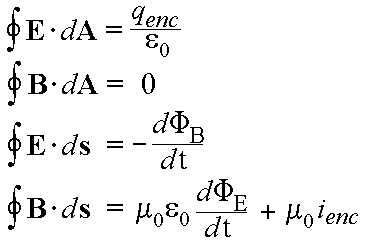![]()
A. Review the key terms, principles, and concepts in your notes..
B. Review the summary of equations at the end of each chapter.
C. Review sample problems done in the book and you notes
D. Review homework and recommended end of chapter problems and exercises
E. Be able to state basic principles in words and mathematically.
![]()
Key Terms and Concepts: Magnetic field (B), magnetic field lines, compass, relation between electric currents and magnetic fields, e/m ratio,CRT, spectrometer, cyclotron. Electromagnets and their application in speakers, generators, electric motors, electric meter, etc. Read about the Hall Effect and be able to distinguish between the units Gauss and Tesla for expression B.
|
|
Be able to trace the magnetic field of a bar and a horse shoe type magnets. |
|
|
Look up Oersted in the Internet. What is he known for? |
|
|
Be able to calculate the magnitude and direction of a force that a moving charge experience when it traverses a magnetic field. i.e,. be able to use F = q(vxB) and the right hand rule. |
|
|
Be able to calculate the magnitude and direction of a force that a current carrying wire experience when it is placed in a magnetic field. i.e,. be able to use F = I(LxB) and the right hand rule. |
|
|
Be able to calculate the torque on a current loop place in a magnetic field ( T = NIAxB). (See example 28-7 |
|
|
Be able to derive an expression for the e/m ratio for a charged beam in a CRT(Section28-4 & 28-6), mass spectrometer (section 28-6), as well as some other arrangement that will be derived in class. |
Ch. 29: Magnetic Fields (B) due to electric currents (I)
|
|
Be able to write down Biot-Savrt Law |
|
|
Using Amper's Law be able to derive the magnetic field around a straight, very long , current carrying wire . |
|
|
Using Amper's Law be able to derive the magnetic field inside a very long solenoid and a toroid . |
|
|
Be able to calculate the force between two parallel and long current carrying wires |
|
|
When do two current carrying wires attract each other? When do thy repel each other? |
|
|
Rework all the sample problems in the chapter |
Ch. 30: Faraday's Law of Induction
|
|
Be able to state mathematically and in word's Faraday's Law and Lenz's Law. ( |
|
|
In the class demonstration, two identical looking blue rods were drooped into an aluminum tube. One of them fell freely while the other one took a very long time to fell through. How is this explained. |
|
|
Be able to calculate the EM induced in a conductor moving across a magnetic field.(see sample problems. |
|
|
Be able to derive the EMF due to a generator -- a coil that rotates inside a magnetic field- using Faraday's Law. Why is the EMF not a constant.(work out probelms .At least the sample problems) |
|
|
Be able to explain the purpose of the alternator(generat0r ) in your car. |
Ch. 32 Maxwell's equations
( See the equations above and Table
32-1)
Be able to list four of Maxwell's equations and be able to identify which corresponds to:
|
|
a) Gauss' Law for Electric fields |
|
|
b) Gauss' Law for Magnetic Fields |
|
|
c) Faraday's and Lenz's Law and |
|
|
d) Modified Ampere's Law. |
|
|
How did Maxwell derive that all EM waves travel at the speed of light. (see equation 33-3 and equation 33-18) |
|
|
What do the acronyms AM and FM stand for ? Which one is more clear and why? which signal goes further? |
We will have test #4 on Monday. The problems for the test will come from:
· The last three labs: Image Formation by Lenses and Mirrors, Interference and Diffraction, and Hydrogen Spectra
· The WileyPlus HW from ch28, 29 &30
· You will have a problem related to a mass spectrometer. Study the example on page 747 (Fig. 28-12)that we did in class
· Be able to state mathematically the following laws: Gauss’ Law for Electric Field , Gauss’ Law for Magnetic field, Ampere’s Law (Or its modification, and Faraday’s Law. These laws are all listed in table 32-1 on page 809. They are the famous Maxwell’s Equations upon which all our electronic communication and most electronic gadgets are based.
___________________________________________
____________________________________________________________________________________________________________
Below is the link for physics songs. The songs on Maxwell's equations require knowledge of vector calculus. Those in you book are mathematically simpler.